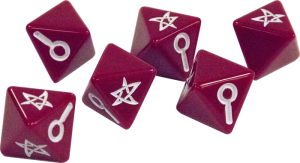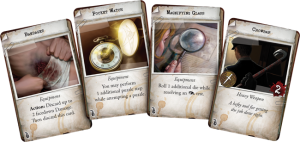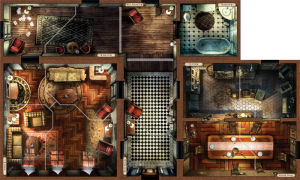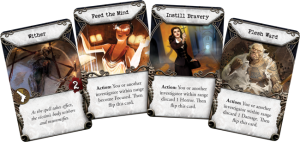Mansions of Madness 2nd Edition – An Immersive Lovecraftian Adventure

Lately I can’t get enough of Mansions of Madness 2nd Edition. I love how immersive it is. It’s as close to a D & D (Dungeons & Dragons) experience as a board game has ever come – that I’ve played so far. The app takes the place of a game master: describing rooms; items and monsters you encounter; directing the monsters and tracking their hit points; and keeping an eye on the timer.
The setting is early 20th century Cthulhu mythos. You and your fellow Investigators are trying to solve a Lovecraftian mystery. I suspect that every mystery involves preventing an Old One from entering our realm and driving everyone insane, but that’s just a guess. I’ve only played one scenario so far. I’ve actually played the same scenario five times – and it was different every time, though the end goal was the same.

The App
Did I mention that Mansions of Madness 2nd Edition is immersive? From the spooky music in the app to the beautiful artwork and eerie descriptions of rooms, monsters, items and the results of your actions, the game takes you there. I’ve seen players literally cringe as a monster was described to them.
Let’s look at how the game plays.
Game Play
Mansions of Madness 2nd Edition is a purely cooperative, app-driven board game in which players work together against the game. Game play is pretty simple: the players take their actions exploring some scary place in search of answers, then the game and its monsters get to take a nip – or bite – out of you with their hair-raising turn.
On your turn, you can take two actions from among the following. You can even perform the same action more than once.
- Move up to 2 spaces. If you’re leaving or moving through a space with a monster, you must Evade first (a test to see if you were able to duck past it). You can break up your movement. For example, you can Move 1 space, Search, then Move another space.
- Search. Examine an item (Search token) in the space you’re on. It could be a painting, a pile of papers, a bookshelf, etc.
- Explore. Open a door, look down a hall, etc. Explore tokens mark areas you can Explore further. The app will describe what you see.
- Attack a Monster in the same space with you, either Unarmed or with a Melee weapon; or you can make a Ranged attack up to 3 spaces away with a Ranged weapon.
- Trade. Exchange any number of Common Items, Unique Items or Spells with other Investigators in the same space as you and/or drop or pick up items on your space. Unfortunately, you can’t Trade Clue tokens.
- Interact with an Interact token, an item in your Inventory, or a Person in your space. Maybe you picked up a book and want to read it or you discovered a strange device and want to experiment with it.
- Component. Use a card’s action like those in the above picture.
- Barricade. Move a Barricade in your space against or away from a door or secret passage. The app is good about specifying what items can be used as Barricades.
- Set Fire. Place a Fire token in your space or on an adjacent space. Requires a Light Source.
- Extinguish. Put out a fire (discard a Fire token) in your space and/or a space you move to. You must make an Agility test to Extinguish a fire successfully.
- Push. Push an Investigator or Monster in your space to an adjacent space. Often requires a Strength test.
- Steal. Take an item from an Investigator in the same space. Requires an Agility, Observation or Strength test.

Mansions of Madness 2nd Ed dice
Your fate is often determined by a roll of the dice, though you can mitigate it somewhat with clue tokens, special abilities, spells or items. How many dice you get to roll is usually determined by one of your character’s stats. Characters also each have their own special ability.
Setup
Setting up the game is as easy as 1, 2, 3 – theoretically:
- Each player chooses a character or you can assign them randomly.
- Read the short 1-page getting started instructions (only necessary the first time you play).
- Open the app and choose an adventure. The app will tell you which room tiles to place on the table to begin your adventure, what items to start with, etc.
I did say theoretically. I would recommend that someone read the rulebook thoroughly in addition to the minimal getting started instructions the game provides. A quick perusal of the FAQs on BGG can be helpful, too.
I made the game much harder for us than it should’ve been the first few times we played. For example, I missed the rule that said monsters’ range doesn’t extend through doorways and another rule that said monsters only attack one Investigator matching the description. If the description of who the monster is supposed to attack applies to more than one Investigator, then the players choose who gets attacked. Because I overlooked that important rule, the monsters got to take a lot more bites out of us than they were supposed to. It made the game a lot harder than it should have been. It was fun, though! My mistakes certainly increased the suspense level!
I also recommend downloading and printing an excellent Investigator Actions Reference Sheet made by Calvin Le Huray from Board Game Geek at:
https://boardgamegeek.com/filepage/135379/
I think it would’ve helped players understand exactly what things they could do on their turn, particularly the first few games.
One of the things I really like about Mansions of Madness 2nd Edition is that it’s easy to add more players midgame by including extra characters during setup. At Here Be Books & Games, we always set up the game for the full compliment of five characters – even if we have fewer players to begin with. Then if another gamer arrives, we can give them one of the extra characters to play, seamlessly working them into the game. If no one shows up to play the extra characters, it’s no problem: we just ignore. The app doesn’t seem to notice either. In the rare instance that the app specifically targets an unplayed character by name, we ignore that instruction. So far it hasn’t affected game play for us at all. However, having extra characters already entered in the app has made it super easy for us to accommodate more players whenever they arrive.
Differences Between 1st & 2nd Editions
I think the second edition of Mansions of Madness is a lot better than the first edition for several reasons:
- You don’t need a game master – the app takes care of that – so everyone can play!
- Setup is pretty quick, particularly if you get a Plano box or something to organize the tokens. It took 30 minutes to an hour of meticulous work to set up the first edition and if the Game Master made one little mistake, it invalidated the whole game!
- It’s fully cooperative. By incorporating an app, Fantasy Flight removed the need for a Game Master, turning a semi-cooperative game (1st edition) into a pure cooperative game (2nd edition).
- It supports solo play. 1st edition required someone to run the game.
The app in 2nd Edition is pretty good – almost excellent. It’s available for Android, Apple, Kindle and Steam. My only gripe is that there is no Back button. If you accidentally hit the wrong button, there’s no going back. I’ve done this a couple of times, it’s frustrating. Otherwise, I love how the app handles the details of the scenarios.
If you have a copy of Mansions of Madness 1st Edition or any of the first edition expansions, don’t get rid of them. You can tell the app what you have and it will increase the variety of encounters and scenarios you can play. I’ve got my eye out to pick up some on the cheap to use with our copy, so if you want to sell them…
My Thoughts

sample item cards
Mansions of Madness 2nd Edition is a really fun, immersive game. It’s not a true roleplaying game experience like Dungeons & Dragons, but it’s the closest I’ve found in a board game. I can’t get enough of it. And we’ve only played one scenario so far – five times! It’s been different every game, so the replayability is there. The base game includes several more scenarios, too.
It took three plays for me to get all the rules right. Not because the rulebook is bad per se, more that it leaves room for interpretation and I interpreted it wrong a few times. The FAQs on Board Game Geek were a big help. I’m planning to compile them into a quick reference and put it with the rulebook. The player aids that I just found today and mentioned earlier should be a big help, too.
The artwork and writing in Mansions of Madness are excellent. The monster minis can be a bit of a pain, though. They don’t have their own bases: you have to stick the minis into the generic bases provided with the game which feature a place to slide in or stand the monster’s reference tile. Unfortunately, some of the minis are prone to topple over.

Mansions of Madness 2nd Ed sample minis
The minis are unpainted. I would’ve preferred pre-painted, but that would have increased the cost of the game, which is already a bit pricey with an MSRP of $99.99. The app is of course free to download. There are a few scenarios you can purchase in-app. Plus, as I mentioned above, if you have any of the first edition stuff, you’ll get access to even more scenarios and in-game content.
Mansions of Madness 2nd Edition is a really fun game. There are rooms to search, items to examine, puzzles to solve, eerie mysteries to investigate and nasty monsters to defeat. Your character may go mad or die in the process. I can’t wait to play it again!
Mansions of Madness 2nd Edition supports 1 to 5 players, ages 14 and up and plays in 2 to 3 hours depending on the scenario.
Copyright © 2018 by Tina G. McDuffie. All rights reserved.Photo rights retained by their respective copyright holders.







Pingback: 13 Spooky Board Games for Halloween - The Glass Meeple